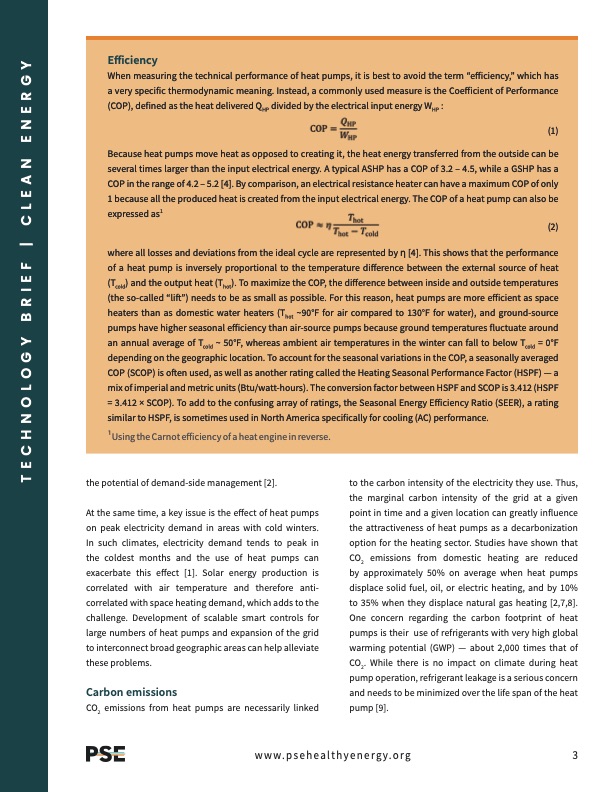
PDF Publication Title:
Text from PDF Page: 003
Efficiency When measuring the technical performance of heat pumps, it is best to avoid the term “efficiency,” which has a very specific thermodynamic meaning. Instead, a commonly used measure is the Coefficient of Performance (COP), defined as the heat delivered QHP divided by the electrical input energy WHP : (1) Because heat pumps move heat as opposed to creating it, the heat energy transferred from the outside can be several times larger than the input electrical energy. A typical ASHP has a COP of 3.2 – 4.5, while a GSHP has a COP in the range of 4.2 – 5.2 [4]. By comparison, an electrical resistance heater can have a maximum COP of only 1 because all the produced heat is created from the input electrical energy. The COP of a heat pump can also be expressed as1 (2) where all losses and deviations from the ideal cycle are represented by η [4]. This shows that the performance of a heat pump is inversely proportional to the temperature difference between the external source of heat (Tcold) and the output heat (Thot). To maximize the COP, the difference between inside and outside temperatures (the so-called “lift”) needs to be as small as possible. For this reason, heat pumps are more efficient as space heaters than as domestic water heaters (Thot ~90°F for air compared to 130°F for water), and ground-source pumps have higher seasonal efficiency than air-source pumps because ground temperatures fluctuate around an annual average of Tcold ~ 50°F, whereas ambient air temperatures in the winter can fall to below Tcold = 0°F depending on the geographic location. To account for the seasonal variations in the COP, a seasonally averaged COP (SCOP) is often used, as well as another rating called the Heating Seasonal Performance Factor (HSPF) — a mix of imperial and metric units (Btu/watt-hours). The conversion factor between HSPF and SCOP is 3.412 (HSPF = 3.412 × SCOP). To add to the confusing array of ratings, the Seasonal Energy Efficiency Ratio (SEER), a rating similar to HSPF, is sometimes used in North America specifically for cooling (AC) performance. 1Using the Carnot efficiency of a heat engine in reverse. the potential of demand-side management [2]. At the same time, a key issue is the effect of heat pumps on peak electricity demand in areas with cold winters. In such climates, electricity demand tends to peak in the coldest months and the use of heat pumps can exacerbate this effect [1]. Solar energy production is correlated with air temperature and therefore anti- correlated with space heating demand, which adds to the challenge. Development of scalable smart controls for large numbers of heat pumps and expansion of the grid to interconnect broad geographic areas can help alleviate these problems. Carbon emissions CO2 emissions from heat pumps are necessarily linked to the carbon intensity of the electricity they use. Thus, the marginal carbon intensity of the grid at a given point in time and a given location can greatly influence the attractiveness of heat pumps as a decarbonization option for the heating sector. Studies have shown that CO2 emissions from domestic heating are reduced by approximately 50% on average when heat pumps displace solid fuel, oil, or electric heating, and by 10% to 35% when they displace natural gas heating [2,7,8]. One concern regarding the carbon footprint of heat pumps is their use of refrigerants with very high global warming potential (GWP) — about 2,000 times that of CO2. While there is no impact on climate during heat pump operation, refrigerant leakage is a serious concern and needs to be minimized over the life span of the heat pump [9]. www.psehealthyenergy.org 3 TECHNOLOGY BRIEF | CLEAN ENERGYPDF Image | Lync heat pump diagram

PDF Search Title:
Lync heat pump diagramOriginal File Name Searched:
HeatPumps.pdfDIY PDF Search: Google It | Yahoo | Bing
CO2 Organic Rankine Cycle Experimenter Platform The supercritical CO2 phase change system is both a heat pump and organic rankine cycle which can be used for those purposes and as a supercritical extractor for advanced subcritical and supercritical extraction technology. Uses include producing nanoparticles, precious metal CO2 extraction, lithium battery recycling, and other applications... More Info
Heat Pumps CO2 ORC Heat Pump System Platform More Info
| CONTACT TEL: 608-238-6001 Email: greg@infinityturbine.com | RSS | AMP |